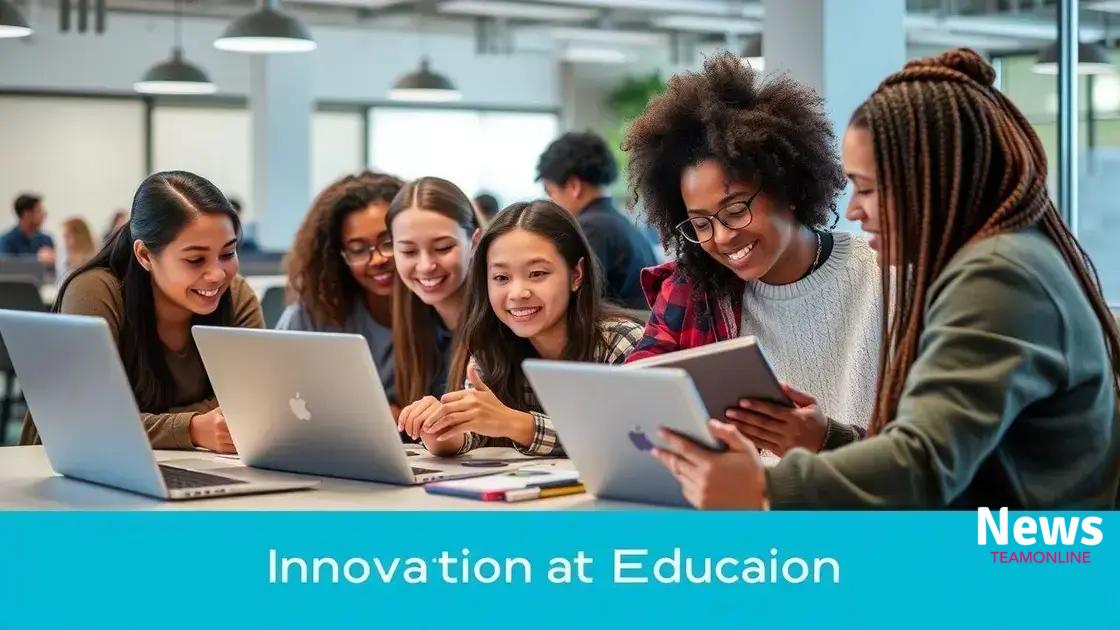Higher ed access equity project: bridging the gap

The Higher Ed Access Equity Project aims to eliminate barriers for underrepresented students, ensuring they have equal opportunities to succeed in higher education through personalized learning, mental health support, and community partnerships.
Higher ed access equity project aims to ensure that all students, regardless of their background, have the opportunity to succeed in higher education. How do we level the playing field and create a more inclusive academic environment?
Understanding higher ed access equity
Understanding higher ed access equity is essential for creating a fair educational landscape. It involves recognizing the barriers that prevent students from various backgrounds from achieving their academic goals. Ensuring equal access means providing support and resources for all learners.
Many factors contribute to inequities in higher education. For instance, financial challenges often play a significant role. Students from low-income families may struggle to afford tuition, books, and living expenses. Additionally, other obstacles such as geographic location and systemic biases can hinder access.
Key factors influencing access equity
There are several key factors that colleges and universities need to address to enhance access equity:
- Financial aid availability: Increasing funding and scholarships can significantly assist low-income students.
- Community outreach: Actively engaging with underrepresented communities helps raise awareness of available opportunities.
- Support services: Providing academic counseling and mentoring can guide students through their educational journey.
Furthermore, the role of technology in higher education cannot be overlooked. Online learning platforms can bridge gaps for students who may have mobility or transportation issues. These tools make it possible for everyone to learn in a flexible environment tailored to their needs.
Lastly, fostering a culture of inclusivity within educational institutions is vital. Encouraging diversity not only enriches the learning experience but also supports various perspectives in classrooms. This approach cultivates a sense of belonging among all students, further promoting educational equity.
Key challenges in achieving access equity
Achieving access equity in higher education is not without its challenges. Many factors hinder progress, making it difficult for students to gain the support they need. Identifying these key challenges is crucial for developing effective solutions.
One major challenge is the lack of financial resources. For many students, the cost of tuition and other educational expenses can be overwhelming. Even with financial aid, the burden may still be too heavy for low-income families. This often leads to students not pursuing higher education altogether.
Cultural and systemic barriers
Cultural perceptions can also impact students’ decisions to attend college. Some individuals may not see higher education as attainable due to their background or community. This mindset can create a cycle of limited expectations. Additionally, systemic barriers within educational institutions can make it hard for underrepresented students to thrive.
- Limited access to information: Many students do not receive adequate information about college opportunities or financial aid.
- Disparities in school funding: Schools in affluent neighborhoods often have more resources, providing a better preparatory experience.
- Bias in college admissions: Admission processes may favor certain demographics, leaving others at a disadvantage.
Another challenge lies in the perception of academic preparedness. Some students may not feel ready for the rigors of college-level work, especially if they did not have access to advanced courses in high school. To mitigate this issue, institutions can offer bridge programs that provide additional support before students enroll.
Technology can be a double-edged sword in this context. While it can enhance learning opportunities, not all students have access to reliable internet or devices. This digital divide can widen the gap in educational equity and needs to be addressed.
Innovative strategies for improvement

Innovative strategies for improving access equity in higher education focus on breaking down barriers and creating opportunities for all students. Implementing fresh ideas can help to level the playing field and support underrepresented groups.
One effective approach is to enhance community partnerships. Educational institutions can collaborate with local organizations to provide resources, mentorship, and guidance for students. These relationships foster a support system that encourages college attendance.
Utilizing technology
Leveraging technology to improve access is another strategy. Online platforms can offer courses and resources to students who may not have access to traditional learning environments. For example, virtual tutoring and open educational resources can provide valuable assistance.
- Flexible learning options: Online courses allow students to work at their own pace, making education more accessible.
- Mobile learning tools: Apps that facilitate studying and homework help students stay engaged.
- Data analysis: Using data to identify trends can help institutions target specific needs within their student population.
Another innovative tactic is the creation of holistic admissions processes. These processes consider a variety of factors beyond standard test scores. By evaluating personal experiences, community involvement, and challenges faced, colleges can better identify potential students who may thrive in their programs.
Furthermore, implementing mentorship programs that pair incoming students with upperclassmen or alumni can significantly enhance support. Mentors can provide guidance, share strategies for success, and create a network that fosters connections.
Case studies of success
Case studies of success in the field of higher ed access equity highlight the effective strategies that various institutions have used to improve opportunities for underrepresented students. These examples serve as inspiration and offer practical solutions to the challenges faced in education.
One notable case is the Bridge Program at a community college. This program provides incoming students with summer classes focused on academic skills and college readiness. As a result, students who participate are more likely to succeed in their courses and complete their degrees.
Targeting specific groups
Another success story comes from a university that implemented a mentorship initiative specifically for first-generation college students. Through this program, trained mentors provide support and guidance, helping students navigate college life. This has led to increased retention rates and stronger academic performance among participants.
- Increased connections: Students report feeling more connected and engaged.
- Higher graduation rates: Many students in mentorship programs successfully graduate on time.
- Enhanced skill development: Students gain vital skills that prepare them for the workforce.
Additionally, a statewide initiative has been launched to improve college access for low-income students. This program offers workshops on financial aid, college applications, and test preparation. As a result, there has been a measurable increase in applications from low-income students to universities across the state.
These case studies demonstrate that focused efforts can lead to substantial improvements in access equity. By learning from these successes, other institutions can adopt similar strategies to create more inclusive educational environments.
Future trends in educational equity
Future trends in educational equity are developing rapidly as technology and social awareness evolve. These trends aim to level the playing field for all students, ensuring fair access to learning opportunities.
One key trend is the rise of personalized learning. With advancements in educational technology, teachers can tailor their approaches to meet individual student needs. This customization helps students learn at their own pace and improves engagement.
Emphasis on mental health
As society becomes more aware of mental health issues, schools are starting to prioritize emotional well-being. Providing necessary resources and support systems will help create a more inclusive environment. Schools are implementing counseling services and educational programs focused on mental health awareness.
- Increased access to counselors: More schools are hiring additional mental health professionals.
- Social-emotional learning programs: These programs teach students coping strategies and emotional skills.
- Community partnerships: Collaborations with local mental health organizations provide additional support.
An increasing focus on diversity and inclusion initiatives is also shaping the future of educational equity. Schools are embracing diversity in their policies and practices, ensuring that all students feel welcome and valued. Training educators on cultural competency can help foster an environment where every student’s background is celebrated.
Another trend is the growing influence of data analytics in improving educational outcomes. Schools are using data to identify gaps in student achievement and access. By analyzing this information, educators can implement strategies that directly address the needs of diverse populations.
FAQ – Frequently Asked Questions about Higher Ed Access Equity
What is access equity in higher education?
Access equity ensures that all students, regardless of their background, have fair opportunities to pursue and succeed in higher education.
How can personalized learning improve educational outcomes?
Personalized learning tailors educational experiences to meet individual student needs, helping them to engage and succeed at their own pace.
Why is mental health support important in schools?
Mental health support helps students manage stress and emotional challenges, which can improve their overall academic performance and well-being.
What role do community partnerships play in educational equity?
Community partnerships provide resources and support to schools, helping to create a more inclusive environment for all students.





